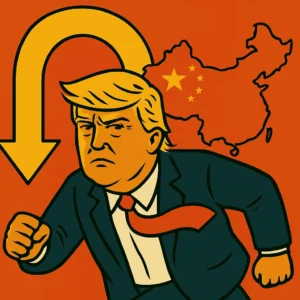 In a move that’s left markets reeling and analysts scratching their heads, President Donald Trump has once again flipped the script on his tariff policy. On April 13, 2025, just days after doubling down on crushing levies against China, Trump’s administration announced a surprise exemption for smartphones, computers, semiconductors, and other electronics from the steep 145% tariffs slapped on Chinese imports. This abrupt reversal—after weeks of escalating trade war rhetoric—has sparked a rally in tech stocks, relief for companies like Apple, and a firestorm of questions about what’s next in Trump’s unpredictable trade saga. Here’s how it all went down and what it means for the U.S. economy. Key Points
In a move that’s left markets reeling and analysts scratching their heads, President Donald Trump has once again flipped the script on his tariff policy. On April 13, 2025, just days after doubling down on crushing levies against China, Trump’s administration announced a surprise exemption for smartphones, computers, semiconductors, and other electronics from the steep 145% tariffs slapped on Chinese imports. This abrupt reversal—after weeks of escalating trade war rhetoric—has sparked a rally in tech stocks, relief for companies like Apple, and a firestorm of questions about what’s next in Trump’s unpredictable trade saga. Here’s how it all went down and what it means for the U.S. economy. Key Points
-
- Trump’s administration exempted smartphones, computers, and semiconductors from China’s 145% tariffs on April 13, reversing earlier hardline stance.
- The move sent tech stocks soaring, with Apple and Nvidia gaining, but Trump hinted at future “national security” tariffs on electronics.
- China called the exemption a “small step” but urged full tariff cancellation, while global markets remain jittery.
- Social media buzz on X reflects confusion, with some praising the reprieve and others slamming Trump’s flip-flopping.
The Tariff Rollercoaster
Trump’s trade war with China has been a wild ride. On April 2, he rolled out a 10% baseline tariff on imports from over 180 countries, with “reciprocal” rates hitting China at 34% and Europe at 20%. Markets tanked—the Dow dropped 2,200 points in two days, and the S&P 500 shed nearly 10%. By April 9, Trump paused tariffs for 75 countries for 90 days but cranked China’s to 125%, citing Beijing’s 84% retaliation. Gold hit record highs, and the dollar wobbled as investors fled to safe havens. Then, on April 13, the U.S. Customs and Border Protection agency quietly published a list of tariff codes sparing electronics—retroactive to April 5—prompting a market surge.
Electronics Get a Breather
The exemptions are a big win for tech giants. Apple, Nvidia, and Dell dodged a bullet, as tariffs threatened to jack up iPhone and laptop prices. The reprieve covers memory cards, routers, flash drives, and more, most of which aren’t made in the U.S. White House spokesperson Karoline Leavitt said Trump wants these industries stateside, but for now, he’s sparing consumers the pain. China’s Ministry of Commerce called it a “small step” toward fixing “unilateral” wrongs but insisted the U.S. must ditch tariffs entirely, per Reuters. On X, users like @KemiRoza32655 cheered the move as a nod to a potential China deal, while @marlene4719 blasted Trump’s “insane” reversals.
Why the Flip?
So, what changed? Pressure, for one. Tech CEOs, cozying up to Trump since his January inauguration, likely leaned hard—Apple’s Tim Cook even hosted a pre-inaugural bash. The threat of pricier gadgets spooked consumers, with some rushing to Apple stores pre-exemption, per The New York Times. Plus, markets were bleeding: the Nasdaq was down 11% before the April 9 rally. Trump’s team, including Commerce Secretary Howard Lutnick, may have seen the writing on the wall—higher tariffs could choke growth and alienate voters. But Trump’s not done: he posted on Truth Social that electronics are just moving to a “different tariff bucket” for a national security probe, hinting at new levies in months.
Market and Global Reactions
The exemption sparked a tech stock frenzy—Nvidia and TSMC jumped, and retail stocks like Wayfair climbed 18%. But Trump’s mixed signals sowed confusion. Lutnick told ABC’s “This Week” that separate tariffs on electronics are coming, tied to national security, not reciprocal rates. China, unfazed, raised U.S. tariffs to 125% on April 12, per Yahoo Finance. On X, @NeutralObservrX claimed China’s “won” economically, while @amtvmedia urged selling the dollar, predicting more chaos. Ray Dalio, on NBC, warned of a looming recession—or worse—if tariffs aren’t handled carefully.
What’s Next for Trade and Tech?
This reprieve buys time, but the clock’s ticking. Trump’s team, led by Trade Representative Jamieson Greer, aims for trade deals within 90 days, but China’s out of that loop. A Section 232 probe into chips could bring new tariffs by June, potentially at 25%, far below the current 145%. The dollar’s still shaky, down 1% since April 9, while gold’s near $3,150, signaling persistent fear. If Trump keeps zigzagging, markets—and consumers—face more whiplash. For now, your iPhone’s cheaper, but in Trump’s trade war, nothing’s certain except the drama.